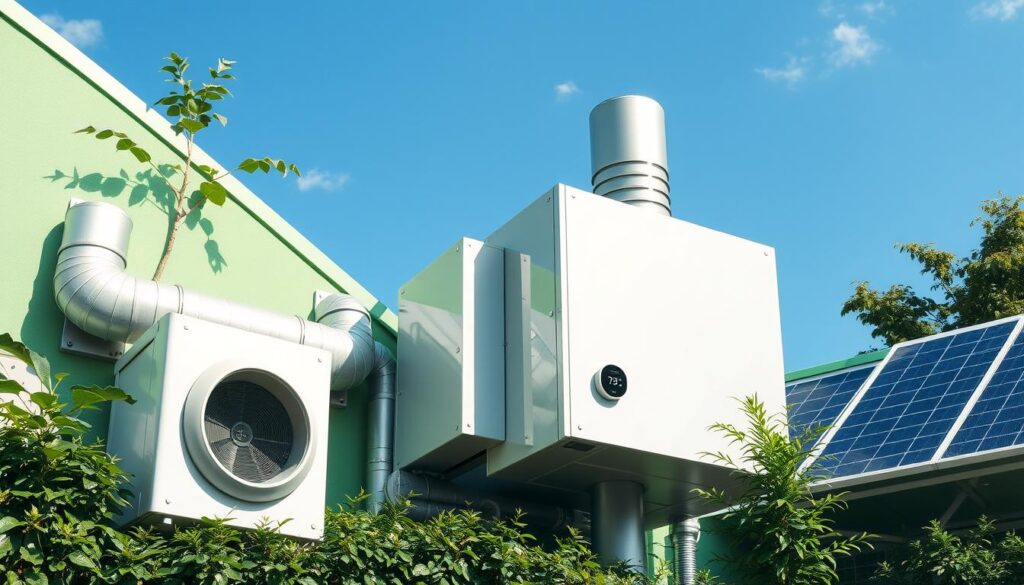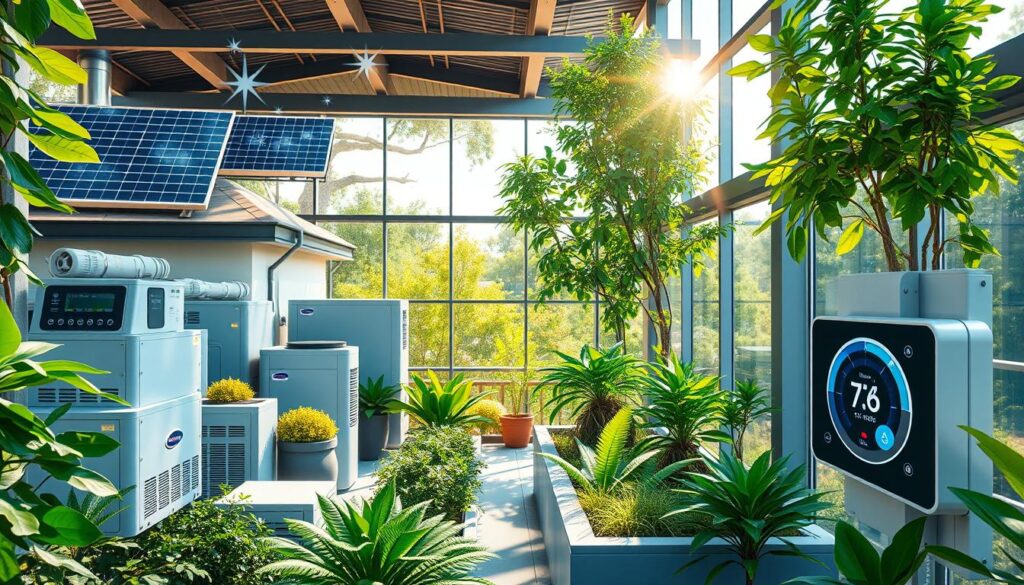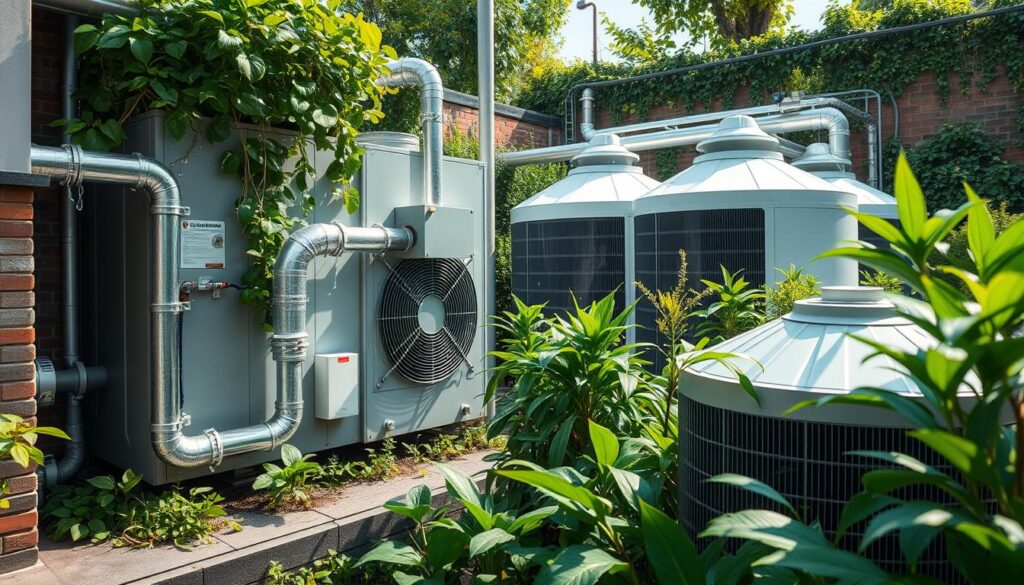Affiliate Disclosure
HVAC Guide Guys is a participant in the Amazon Services LLC Associates Program, an affiliate advertising program designed to provide a means for sites to earn advertising fees by advertising and linking to Amazon.
Are HVAC Systems Sustainable? HVAC systems are key in making buildings and homes energy-efficient. They use a lot of energy, but can they be green? This guide will show how HVAC systems can help make our future greener.

Key Takeaways
- HVAC systems can consume up to 50% of a building’s total energy load, highlighting the importance of sustainable practices.
- Smart, connected HVAC systems can be programmed for optimal efficiency, responding to user preferences and grid conditions.
- Proper selection and maintenance of HVAC equipment can lead to significant cost savings and reduced environmental impact.
- The ASHRAE GreenGuide provides comprehensive guidance on sustainable building design, including HVAC systems.
- Sustainable HVAC practices can play a crucial role in creating energy-efficient and environmentally-friendly buildings.
Table of Contents
Understanding HVAC Systems and Sustainability
HVAC (Heating, Ventilation, and Air Conditioning) systems are key in modern buildings. They keep the air inside comfortable and clean. These systems have many parts that work together. Knowing how they work helps us see how they affect the environment.
Basic Components and Functions
HVAC systems have a few main parts:
- Furnaces or boilers for heating
- Air conditioning units for cooling
- Ductwork for air distribution
- Ventilation fans and filters for air circulation and filtration
- Thermostats and control systems for temperature and humidity regulation
The Role of HVAC in Modern Buildings
In today’s buildings, HVAC systems are vital. They help keep the air inside comfortable and clean. They use a lot of energy, which makes them a big target for making buildings greener.
By making HVAC systems work better and adding green tech, we can use less energy. This lowers carbon emissions and makes buildings more eco-friendly.
Environmental Impact Overview
HVAC systems affect the environment mainly because of energy use, greenhouse gases, and water. Most HVAC systems use fossil fuels, which harm the planet. They also use water for cooling.
Green HVAC design aims to lessen these impacts. It keeps the air inside comfy and clean while being kinder to the planet.
Explore Our HVAC Shop
Looking for top-rated HVAC tools, parts, and accessories? Visit our shop and find the perfect solution for your needs.
Visit the ShopThe Current State of HVAC Energy Consumption
HVAC systems are key in modern buildings but use a lot of energy. In the U.S., they can use up to 50% of a home’s energy. Many systems are not used well, leading to wasted energy and higher bills.
More HVAC systems are being installed every year. It’s important to size them right to avoid wasting energy. The U.S. Department of Energy says new, efficient systems can cut energy use by half or more.
| Key Statistic | Value |
|---|---|
| Annual HVAC system replacements in the U.S. | 3 million |
| Annual spending on HVAC services or repairs in the U.S. | $14 billion |
| Percentage of home energy usage for heating and cooling | 50% |
| Potential energy savings from ENERGY STAR certified HVAC equipment | 10-30% |
| Energy loss due to duct leakage, holes, and unconnected ducts | Up to 20% |
| Potential energy use increase from HVAC systems installed without performance verification | Up to 30% |
The U.S. Department of Energy is working on projects to make HVAC systems more efficient. Smart HVAC technologies will be key in cutting down HVAC energy use, residential energy consumption, and energy waste.
“HVAC equipment can represent roughly 40%-60% of a building’s total energy consumption in commercial buildings.”
The demand for energy-efficient HVAC solutions is growing. The industry must tackle current challenges and use new technologies. This will help reduce HVAC energy use, residential energy consumption, and energy waste in homes and businesses.
Smart HVAC Technologies Driving Sustainability
The HVAC industry is moving towards sustainability with new technologies. These include 4G-enabled systems and advanced energy management software. They change how buildings control their climate.
4G-Enabled HVAC Systems
4G-enabled HVAC systems are changing how buildings use energy. They use real-time data to adjust cooling and heating. This can cut energy use by up to 30%.
Programmable Thermostats
Programmable thermostats are key to HVAC sustainability. They let users set temperature schedules. This can save up to $180 a year on energy bills.
Energy Management Software Solutions
Energy management software lets building owners control their HVAC systems better. It makes adjustments based on occupancy and weather. This can greatly reduce energy use and costs.
These smart technologies are leading to a sustainable future in HVAC. With 4G, programmable thermostats, and energy management software, buildings can be more efficient and green.
Explore Our HVAC Shop
Looking for top-rated HVAC tools, parts, and accessories? Visit our shop and find the perfect solution for your needs.
Visit the ShopAre HVAC Systems Sustainable? Key Factors to Consider
Several important factors affect the sustainability of HVAC systems. These include design, installation quality, maintenance, and technology advancements. Each plays a big role in the system’s environmental impact.
Energy-efficient HVAC models are key to sustainable cooling. Choosing systems with high-efficiency ratings, like ENERGY STAR, cuts down energy use and costs. It’s also important to size the HVAC system right for the building’s needs.
Regular maintenance is crucial for HVAC sustainability. Keeping the system in top shape through tune-ups, filter changes, and inspections boosts efficiency. It also helps the equipment last longer, saving energy and reducing environmental harm.
Using renewable energy sources like solar power and alternative cooling methods like geothermal heat pumps can greatly reduce HVAC’s carbon footprint. These innovations help make HVAC systems more sustainable for the future.
The building’s design also affects HVAC system efficiency and sustainability. Things like insulation, window placement, and shading can make a big difference. By considering these, you can improve the system’s performance and lower its environmental impact.
| HVAC Sustainability Factor | Impact on Sustainability |
|---|---|
| Energy-efficient equipment | Reduces energy consumption and utility costs |
| Proper system sizing | Ensures optimal performance and efficiency |
| Regular maintenance | Maintains peak efficiency and extends equipment lifespan |
| Renewable energy integration | Lowers carbon footprint and reliance on grid electricity |
| Building design considerations | Enhances HVAC efficiency and sustainability |
By focusing on these key factors, HVAC systems can be made more sustainable. This leads to a greener, more energy-efficient future.

Energy Efficiency Ratings and Standards
As we look for ways to save energy, knowing about different ratings and standards is key. ENERGY STAR, LEED, and industry benchmarks help us find the most efficient HVAC systems. These tools are important for making smart choices.
ENERGY STAR Certification
The ENERGY STAR program, run by the U.S. Environmental Protection Agency (EPA), highlights top energy-saving HVAC systems. Choosing ENERGY STAR HVAC can cut energy bills by over $115 a year. It’s good for your wallet and the planet.
LEED Certification
The LEED certification program, by the U.S. Green Building Council, looks at HVAC efficiency. It’s part of what makes a building green. HVAC systems that meet LEED’s high standards are key to getting this honor.
Industry Benchmarks
The industry uses SEER for cooling and HSPF for heat pumps to measure efficiency. The ANSI/ASHRAE/USGBC/IES Standard 189.1 also sets energy efficiency standards for green buildings. These benchmarks help ensure HVAC systems are up to par.
New ENERGY STAR HVAC, LEED certification, and energy efficiency standards keep coming. It’s vital for homeowners and building owners to stay updated. This way, they can make the best choices for their HVAC needs.
Explore Our HVAC Shop
Looking for top-rated HVAC tools, parts, and accessories? Visit our shop and find the perfect solution for your needs.
Visit the ShopWater Conservation in HVAC Systems
HVAC systems use a lot of water, especially in big commercial buildings. They can use up to 48% of a building’s water, mostly for cooling towers. If these systems aren’t efficient, they waste a lot of water and harm the environment. But, smart water-saving steps can cut down the water used by HVAC systems a lot.
One key way to save water is to watch water levels and use drift eliminators in cooling towers. This cuts down on water lost to evaporation. Also, using better insulation, shading, and efficient equipment can reduce the water needed for cooling.
Another good idea is to use the water from air conditioning units for other things. This “gray water” can water lawns or wash cars, saving up to 20 gallons a day. Using rainwater to help with cooling tower water needs can also cut down on the need for city water.
| Facility Type | Water Savings |
|---|---|
| Airport (1,500,000 sq ft, 12,000 tons cooling) | 4,013,000 gallons per year |
| Data Center (500,000 sq ft, 3,000 tons cooling) | 778,518 gallons per year |
By using these and other water-saving methods, HVAC systems can lessen their harm to the environment. Investing in efficient HVAC equipment and adding water-saving features can save a lot of water and money in the long run.

Carbon Footprint Reduction Strategies
Reducing the carbon footprint is key in finding sustainable HVAC solutions. HVAC systems use a lot of energy, making up about 10% of global greenhouse gas emissions. But, using renewable energy and new cooling methods can help businesses lessen their environmental impact.
Renewable Energy Integration
Using renewable energy is a great way to cut down on HVAC carbon footprint. Solar thermal units and high-efficiency heat pumps use less fossil fuel. Thermal energy storage facilities also help use energy better. These technologies can even help get LEED certification, encouraging more sustainable HVAC practices.
Alternative Cooling Methods
There are also cool alternatives to traditional air conditioning. Evaporative cooling uses evaporation to cool, which is better for the environment. Night purge ventilation uses cool air at night to lower indoor temperatures, reducing HVAC energy use.
Emission Control Measures
Emission control is also vital in lowering HVAC carbon footprint. Regular maintenance, like duct and coil cleaning, can boost system efficiency by up to 30%, the U.S. Department of Energy says. Upgrading to high-efficiency systems and using smart thermostats also cuts down on energy use and emissions.
By using these strategies, businesses can help the environment and save money in the long run. They’ll also see better operational efficiency.
Proper Maintenance for Sustainable Operation
Keeping your HVAC system in good shape is key for saving energy and being eco-friendly. Regular maintenance helps your system work better, cuts down on energy bills, and reduces harm to the environment.
First, change your air filters every three months. Dirty filters make your system work harder and use more energy. During yearly check-ups, a technician will inspect and clean your system, checking refrigerant and airflow for top performance.
Sealing and insulating your ducts is also crucial. Duct leaks can waste up to 30% of energy, hurting your system’s performance. Keeping your ducts well-maintained and insulated stops conditioned air from escaping, making your HVAC system more energy-efficient.
Cleaning your coils, fan blades, and other parts is vital for sustainable HVAC practices. Dirt and debris can lower efficiency, increasing energy use and costs. Clean parts mean a better-working HVAC system.
Focus on HVAC maintenance to keep your system efficient and eco-friendly. Simple steps can lead to a greener HVAC system and lower your carbon footprint.
Explore Our HVAC Shop
Looking for top-rated HVAC tools, parts, and accessories? Visit our shop and find the perfect solution for your needs.
Visit the ShopCost-Benefit Analysis of Green HVAC Systems
Thinking about switching to a greener HVAC system? It’s worth looking at the costs and benefits. Although they might cost more upfront, the long-term savings and good for the planet make them a wise choice.
Initial Investment Considerations
The cost of a new HVAC system can vary. It depends on the unit size, installation, and any needed changes to your home. But, you can get help from rebates and government programs to lower the cost.
Long-term Savings Potential
Green HVAC systems can save a lot of money each year. This can add up to thousands over 10 years, covering the initial cost. Plus, they can even increase your home’s value by up to $5,000.
Environmental Returns
Green HVAC systems are also great for the planet. They use less energy than old systems, cutting down on carbon emissions. This helps make our environment cleaner and more sustainable.
When you look at the costs and benefits, the payback time varies. It depends on your energy costs, how much you use it, and any incentives. Still, the long-term savings and benefits to the environment are strong reasons to choose energy-efficient HVAC.
| Metric | Value |
|---|---|
| Initial Investment | $11,500 – $20,000 |
| Annual Operational Savings | $1,200 – $2,250 |
| Lifetime Savings (10 years) | $12,000 – $22,500 |
| Property Value Increase | $5,000 |
| Payback Period | 2 – 10 years |
| ROI | 139.13% (example) |
The table shows the benefits of green HVAC systems. It highlights the energy savings, environmental benefits, and green HVAC cost aspects. By considering these, you can make a smart choice for your home or business.
Future Trends in Sustainable HVAC Technology
The need for energy-saving and eco-friendly HVAC systems is on the rise. The HVAC industry is set for big changes. It will see the use of artificial intelligence and new refrigerants, all aimed at saving energy and being kind to the planet.
AI-powered HVAC systems are becoming popular. They learn what you like and adjust to save energy and keep you comfortable. They work well with smart homes, making energy use better and temperature control more precise. Also, new refrigerants are being made that are better for the environment, reducing the harm HVAC systems can cause.
Variable refrigerant flow (VRF) systems are also on the rise. They offer better zoning and energy use than old HVAC designs. Heat pumps, which can both heat and cool, are becoming more common. They help make HVAC systems more sustainable. Thermal energy storage, using special materials, is being looked into to make HVAC systems even more efficient.
The HVAC industry is getting ready to use more renewable energy like solar and wind. This will help cut down on fossil fuel use and lower carbon emissions from HVAC systems. With these changes, HVAC systems will be more efficient, save money, and be better for the environment.
“The future of HVAC is not just about energy efficiency – it’s about creating smart, adaptive systems that seamlessly integrate with our homes and workplaces, delivering superior comfort and sustainability.”
Conclusion
Sustainable HVAC systems are key to cutting down energy use, lowering carbon emissions, and saving water. By using energy-efficient tech, regular maintenance, and smart controls, you can greatly reduce your environmental footprint and costs. As HVAC tech keeps improving, we can make homes and workplaces more sustainable and comfortable for everyone.
Choosing green building practices and energy-efficient HVAC systems offers big benefits for your property and the planet. You’ll enjoy a cozy home or office while reducing your carbon footprint and saving money on energy bills. The future looks bright for those who focus on sustainable HVAC and work towards a greener built environment.
By keeping up with HVAC tech advancements and following best practices, you can help create a sustainable future. Whether you’re building a new place or updating an old one, smart choices about your HVAC system matter a lot. Together, we can build a greener, more energy-efficient tomorrow, one HVAC system at a time.

